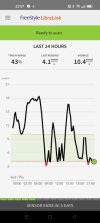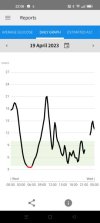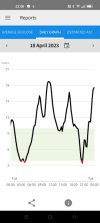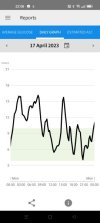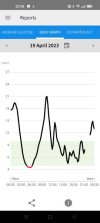OK, looking at the graphs, firstly it would be really helpful if you can notate on the app when you eat (either meals or hypo treatment) and when you inject insulin, as that helps to make more sense of what is going on with the graphs.
It isn't surprising that you are feeling rough with spikes and troughs like that so working on flattening them out should help you to feel better physically and mentally. I too suffer with mental health problems and the more stable I can manage my BG levels the better I am mentally, but I know that when I am going through a bad spell it is hard to focus enough to get back into a good spell, so I am not saying it is easy but I do think we can help you to improve on this.
First graph...

My first question would be.... what did you have for tea and when? Looks like you might have had some "pIzza effect" slow release.... or possibly not enough basal. Was that dip about 1am which brought you down to 10mmols caused by you injecting a correction or could it have been a compression low caused by lying on your sensor in your sleep? If you had notated an insulin dose in the notes this makes it easy to tell. If it is a compression low, then it looks like your levels rose steadily overnight which might suggest looking for a recurring pattern to see if a basal insulin increase is warranted. We don't make changes like that off one day's graph, but it is something I would be looking out for and considering, particularly if you hadn't had a pizza/creamy pasta/fatty or high protein meal the night before.
Next comment is the massive fast drop from 18-3mmols at 7am. I am assuming that was a large correction plus breakfast bolus? Obviously just a bit too much since you hit the red. A large correction (even overly large) is not a problem if you keep a close eye on it and this is the beauty of Libre and ideally head it off before you hit the red line.... which is where your low alarm comes in.
Where do you have your low alarm set?
Mine is 4.2 because I know that even if I am dropping quite fast a couple of well chewed jelly babies (glucose absorbs quicker in the mouth than in the stomach so worth chewing well before you swallow) will stop my levels dropping into the red but I have pretty quick absorption of glucose. You might need your low alarm set at 5 to give you time to turn it around before you go below 4.
In that situation myself I would have been scanning every 10-15 mins once my levels started to drop and if I hit 6 and they were still dropping fast I might eat 1 jelly baby to slow the drop and continue to scan every 5 mins to see how it panned out and then if I got to 4.2 and still dropping I would have another JB.
I see my insulin and carbs sort of as an accelerator and brake, so I use JB here and there to slow down the speed my levels are dropping after a large correction... particularly as I get towards the bottom of my range and before I crash through the red line at the bottom.
Not sure if the spike back up to 12 is your breakfast/brunch kicking in, which is a reasonable spike in the circumstances and levels come back down but then it looks like there may have been some fighting to keep it from dropping too low with those 2 small spikes afterwards (suggesting ratio may possibly be wrong.... but again, not something to decide off one event) before levels rose again which I am guessing may have been lunch. It looks like you come nicely down into range after that, so the only thing to prevent such a high spike would be to prebolus a bit earlier, but if you were fighting to keep levels out of the red before lunch I can see how that would not be a good idea until you get levels more stable. reducing the height of your meal spikes is less important than preventing the hypos and getting your basal dose optimized, so some basal testing should help figure a few things out.
My gut feeling from that graph is that basal is not right and meal time ratios may also not be right and consequently you are fighting 2 different things and nothing is making sense as a result and you are just reacting to problems. Some basal testing.... skipping a meal here and there should start to shed a bit of light on the matter.
If you can start to notate your Libre app with info like insulin injections and carbs and exercise, it will help to interpret it better. Not saying that needs to be forever, but just whilst you are having problems.

